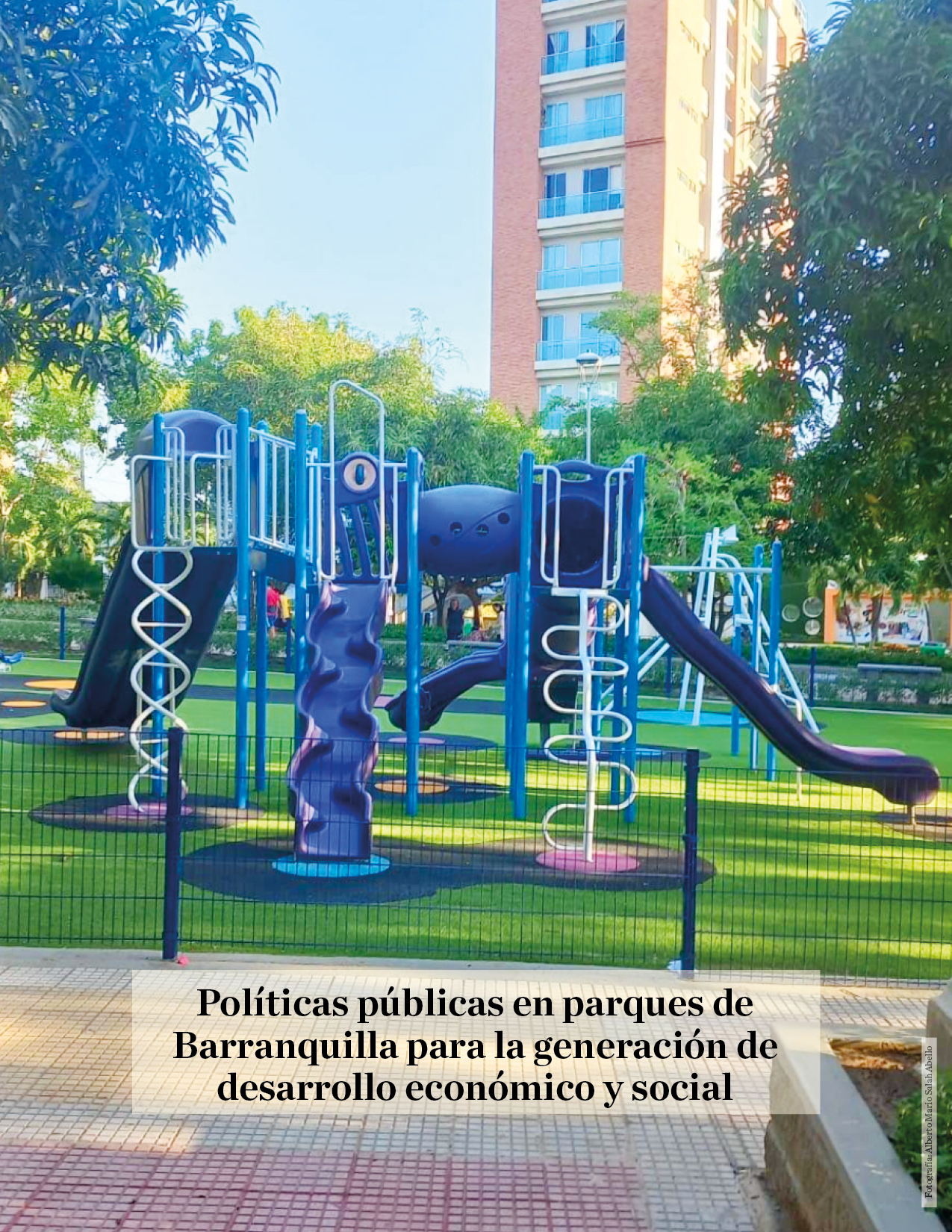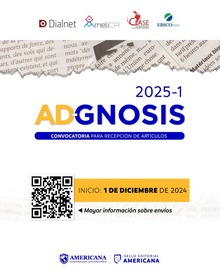Public policies in parks in Barranquilla for the generation of economic and social development.
DOI:
https://doi.org/10.21803/adgnosis.13.13.653Keywords:
Public policies, social development, economic developmentAbstract
Introduction: The development and social impact
generated in the parks of the city of Barranquilla has
aroused great interest, as it has been a mechanism to
promote social development and change in the dynamics of the local economy. Therefore, Objectives: the objective of this article is to analyze public policies applied to parks in the city of Barranquilla that influence economic and social development. Methodology: To carry out this analysis, a methodology was used whose hypothetical-deductive approach of a transversal nature, under the technique documentary analysis and unstructured interview, evidenced in its results that the current policies have allowed to generate more employment and to reduce the delinquency in the city, fundamental aspects for the social progress. Consequently, it is concluded that continued
investment in the development and improvement of parks represents an effective means to promote sustainable growth and social progress in Barranquilla.
Downloads
References
Alcaldía de Barranquilla. (2020, 9 de marzo). En parques, arroyos y arborización, barranquilleros presentan sus ideas para el Plan de Desarrollo. Alcaldía de Barranquilla. https://www.barranquilla.gov.co/adi/plan-de-desarrollo-adi
Alcaldía de Barranquilla. (2022, 14 de febrero). La recuperación de parques en Barranquilla reduce en promedio 15,4% los hurtos en su área de influencia. https://cutt.ly/NwkANoXw
Álvarez Cuellar, F. (2014). Las percepciones psico-sociales-ambientales de la calidad ambiental del humedal eco-parque las garzas por arte de los residentes y visitantes [Tesis de maestría, Universidad del Valle]. Biblioteca digital Univalle. https://hdl.handle.net/10893/14985
Ayala-Azcárraga, C., Diaz, D., & Zambrano, L. (2019). Cha-racteristics of urban parks and their relation to user well-being. Landscape and Urban Planning, 189, 27–35. https://doi.org/10.1016/j.lan-durbplan.2019.04.005
Bahriny, F., & Bell, S. (2020). Patterns of Urban Park Use and Their Relationship to Factors of Quality: A Case Study of Tehran, Iran. Sustainability, 12(4), 1560. https://doi.org/10.3390/su12041560
Barón Rodríguez, Y. (2021). El proceso de transformación urbana y el fenómeno de la gentrificación en Bogotá: Un estudio multitemporal en la UPZ 92 La Macarena, entre los años 2005-2020 [Tesis de pregrado, Universidad Colegio Mayor de Cundinamarca]. Repositorio Universidad Colegio Mayor de Cundinamarca. https://repositorio.unicolmayor.edu.co/handle/unicolmayor/3468
Boano, C. (2011). Whose Public Space? International Case Studies in Urban Design and Development. International Development Planning Review, 33(1), 97-100.
Bonells, J. (2021, 29 de noviembre). Beneficios de los parques urbanos: ¿que sabemos de los beneficios de los parques urbanos?. https://cutt.ly/fwsLrb0T
Carvajalino, J. (2019, 28 de marzo). Beneficios y retos de la recuperación de parques en Barranquilla. Portal noticias Universidad del Norte. https://www.uninorte.edu.co/web/grupo-prensa/w/beneficios-y-retos-de-la-recuperacion-de-parques-en-barranquilla
Cedeño Pérez, M. (2005). Relaciones sociales y prácticas de apropiación espacial en los parques públicos urbanos. (El caso del Parc de Les Planes de L'Hospitalet de Llobregat - Barcelona) [Tesis de doctorado, Universidad de Barcelona]. Repositorio Universidad de Barcelona.
Czortek, Patryk & Pielech, Remi-giusz (2020). Surrounding landsca-pe influences functional diversity of plant species in urban parks. Urban Forestry and Urban Greening, 47(2020). https://doi.org/10.1016/j.ufug.2019.126525
Deng, L., Li, X., Luo, H., Fu, E., Ma, J., Sun, L., Zhou, H., Shi-Zhen, C., & Jia, Y. (2020). Empirical study of lands-cape types, landscape elements and landscape components of the urban park promoting physiological and psy hological restoration. Urban Forestry and Urban Greening, 48. https://doi.org/10.1016/j.ufug.2019.126488
Deutscher, J., Kupec, P., Kučera, A., Urban, J., Ledesma, J., & Futter, M. (2019). Ecohydrological consequences of tree removal in an urban park evaluated using open data, free software and a mini-malist measuring campaign. Science of the Total Environment, 655, 1495–1504. https://doi.org/10.1016/j.scito-tenv.2018.11.277
Dizdaroglu, D. (2022). Developing Design Criteria for Sustainable Urban Parks. Journal of Contemporary Urban Affairs, 6(1), 69-81.
El Heraldo. (2023, 3 de abril). Parques en Barranquilla: 8 de cada 10 usuarios realizan actividad física. El Heraldo. https://www.elheraldo.co/atlantico/parques-en-barranquilla-8-de-cada-10-usuarios-realizan-actividad-fisica-990525
Farji-Brener, A. (2007). Una forma alternativa para la enseñanza del método hipotético-deductivo. Interciencia, 32(10), 716-720. http://ve.scielo.org/scielo.php?script=sci_arttext&pid=S0378-18442007001000015&lng=es&tlng=es.
Faggi, A., & Zuleyka Vidal, C. (2019). Uses and perceived benefits of two Latin-American linear parks. Proceedings of the Institution of Civil Engineers: Municipal Engineer, 172(3), 137–14. https://www.icevirtuallibrary.com/doi/abs/10.1680/jmuen.15.00032
García, A. C. (1993). Análisis documental: el análisis formal. Revista general de información y documentación, 3(1), 11.
Grijalba Rosero, N., & Martínez Pérez, S. (2015). Diseño de un equipamiento urbano orientado a la actividad física como alternativa de entretenimiento en parque públicos de la ciudad de San Juan de Pasto [Tesis de pregrado, Universidad de Nariño]. Repositorio Universidad de Nariño. https://sired.udenar.edu.co/1254/1/91064.pdf
Gómez-Gómez, E. N. (1995). La investigación educativa: de lo hipotético deductivo a lo interpretativo. http://hdl.handle.net/11117/2601
Guarda-Saavedra, P., Muñoz-Quezada, M., Cortinez-O'ryan, A., Aguilar-Farías, N., & Vargas-Gaete, R. (2022). Beneficios de los espacios verdes y actividad física en el bienestar y salud de las personas. Revista Médica de Chile, 150(8): 1095-1107. http://dx.doi.org/10.4067/S0034-98872022000801095
Gaudereto, Guilherme; Gallar-do, Amarilis; Ferreira, Mauricio; do Nascimento, Ana & Mantovani, Waldir (2018). Evaluation of ecosys-tem services and management of urban green areas: Promoting healthy and sustainable cities. Ambiente e Sociedade, 21. https://doi.org/10.1590/1809-4422asoc0120r3vu18L4TD
Hernández, L., Romero, J., & Bracho, N. (2005). Tesis Básicas del Racionalismo Crítico. Cinta De Moebio. Revista de Epistemología de Ciencias Sociales, (23). https://revistahistoriaindigena.uchile.cl/index.php/CDM/article/view/26080
Hurtado Olivera, E.R. (2021) Estrategia de gestión urbana en los parques que optimicen la convivencia y seguridad ciudadana. Estudio de caso: parque guayuriba y parque cuarta etapa esperanza de la ciudad de Villavicencio [Tesis de Maestría, Universidad Piloto de Colombia]. Repositorio Universidad Piloto de Colombia. http://repository.unipiloto.edu.co/handle/20.500.12277/11195
Maassen. A. (2023, 2 de febrero). Revitalizan parques urbanos a ciudad colombiana de Barranquilla. Institute resource world. https://wrimexico.org/bloga/revitalizan-parques-urbanos-ciudad-colombiana-de-barranquilla
Klimovsky, G (1971). El método hipotético deductivo y la lógica. En Memoria Académica. http://www.memoria.fahce.unlp.edu.ar/libros/pm.177/pm.177.pdf
Kong, X., Sun, Y., & Xu, C. (2021). Effects of Urbanization on the Dynamics and Equity of Access to Urban Parks from 2000 to 2015 in Beijing, China. Forests, 12(12), 1796.
Li, J., Pan, Q., Peng, Y., Feng, T., Liu, S., Cai, X., Zhong, C., Yin, Y., & Lai, W. (2020). Perceived Quality of Urban Wetland Parks: A Second-Order Factor Structure Equation Modeling. Sustainability, 12(17), 7204. https://doi.org/10.3390/su12177204
López Yza, O. (2022). Tendencias y consecuencias urbano-arquitectónicas a causa de la violencia urbana y sensación de inseguridad en la ciudad de Xalapa, Veracruz [Tesis de maestría, Universidad Veracruzana]. Repositorio Universidad Veracruzana. https://cdigital.uv.mx/bitstream/handle/1944/52840/LopezYzaOlimpia.pdf?sequence=1
Luo, T., Yang, F., Wu, L. & Gao, X. (2020). Equity evaluation of urban park system: A case study of Xiamen, China. Journal of Environmental Engineering and Landscape Management, 28(3), 125–136. https://doi.org/10.3846/je-elm.2020.12704
Martínez Castillo, M. (2022). Parques reducen los delitos en sus áreas de influencia. El Heraldo. https://www.elheraldo.co/barranquilla/parques-reducen-el-154-de-hurtos-en-areas-de-influencia-887488
Martínez-Valdés, V., Silva Rivera, E. & González Gaudiano, E. (2020). Parques urbanos: un enfoque para su estudio como espacio público. Intersticios sociales, (19), 67-86. http://www.scielo.org.mx/scielo.php?script=sci_arttext&pid=S2007-49642020000100067&lng=es&tlng=es.
Ma, K., Mak, C., & Wong, H. M. (2021). Effects of environmental sound quality on soundscape preference in a public urban space. Applied Acoustics, 171. https://doi.or-g/10.1016/j.apacoust.2020.107570
Medrano Álvarez, L. & Quintero Gonzáles, J. (2020). Los parques urbanos como elemento de la ciudad: beneficios ambientales, sociales y económicos. Temas de arquitectura, 11(1), 93-112.
Medrano Álvarez, L. J., & Quintero González, J. R. (2021). Experiencias de valoración de los parques urbanos en las ciudades. Contextos regionales, prospectiva para Colombia. AREA - Agenda De Reflexión En Arquitectura, Diseño Y Urbanismo, 27(1), 1-13. publicacionescientificas.fadu.uba.ar/index.php/area/article/view/1819
Medina Bermúdez, C. I. (2001). Paradigmas de la investigación sobre lo cuantitativo y lo cualitativo. Ciencia E Ingeniería Neogranadina, 10, 79-84. https://doi.org/10.18359/rcin.1382
Nagendra, H., & Gopal, D. (2011). Tree diversity, distribution, history and change in urban parks: Studies in Bangalore, India. Urban Ecosystems, 14(2), 211–223. https://doi.org/10.1007/s11252-010-0148-1
Neckel, A., Da Silva, J., Saraiva, P., Kujawa, H., Araldi, J. & Paladini, E. (2020). Estimation of the economic value of urban parks in Brazil, the case of the City of Passo Fundo. Journal of Cleaner Production, 264, 1–11. https://doi.org/10.1016/j.jclepro.2020.121369
Nielsen, Anders; van den Bosch, Matilda; Maruthaveeran, Sreetheran & van den Bosch, Cecil (2014). Species richness in urban parks and its drivers: A review of empirical evidence. Urban Ecosystems, 17(1), 305–327. https://doi.org/10.1007/s11252-013-0316-1
Ocampo Eljaiek, D. R. (2008). Los espacios urbanos recreativos como herramienta de productividad. Revista Escuela de Administración de Negocios, (63), 107-126.
Orstad, S. L., Szuhany, K., Tamura, K., Thorpe, L. E., & Jay, M. (2020). Park Proximity and Use for Physical Activity among Urban Residents: Associations with Mental Health. International Journal of Environmental Research and Public Health, 17(13), 4885. https://doi.org/10.3390/ijerph17134885
Perelman, P. E., & Marconi, P. L. (2016). Percepción del verde urbano en parques de la ciudad de Buenos Aires. Multequina, 25(1), 13-22. http://www.scielo.org.ar/scielo.php?script=sci_arttext&pid=S1852-73292016000100002
Pérez, Betty M. (2014). Salud: entre la actividad física y el sedentarismo. Anales Venezolanos de Nutrición, 27(1), 119-128. http://ve.scielo.org/scielo.php?script=sci_arttext&pid=S0798-07522014000100017&lng=es&tlng=es
Peters, K., Elands, B, & Buijs, A. (2010). Social interactions in urban parks: Stimulating social cohesion?. Urban Forestry & Urban Greening, 9 (2), 93-100. https://doi.org/10.1016/j.ufug.2009.11.003
Tu, X., Huang, G., Wu, J., & Guo, X. (2020). How do travel distance and park size influence urban park visits? Urban Forestry and Urban Greening, 52. https://doi.org/10.1016/j.ufug.2020.126689
Ruiz, J., Parra, E., & López Carr, D. (2015). A Geographical View of Urban Parks in the City of Tunja, Boyacá, Colombia. Perspectiva Geográfica, 20(2), 245–268. http://www.scielo.org.co/pdf/pgeo/v20n2/v20n2a02.pdf
Sánchez, M. J., Fernández, M., & Diaz, J. C. (2021). Técnicas e instrumentos de recolección de información: análisis y procesamiento realizado por el investigador cualitativo. Revista Científica UISRAEL, 8(1), 107-121. https://doi.org/10.35290/rcui.v8n1.2021.400
Salazar-Arenas, O. (2007). Free time outdoors. Social practices, public space and nature at the Enrique Olaya Herrera National Park (1938-1948). Historia Critica, 33, 186–208. https:// doi.org/10.7440/histcrit33.2007.07
Sim, J., Bohannon, C., & Miller, P., (2020). What park visitors survey tells us: Comparing three elevated parks the high line, 606, and high bridge. Sustainability, 12(1). https://doi.org/10.3390/su12010121
Song, Y., Fernandez, J., & Wang, T. (2020). Understanding Perceived Site Qualities and Experiences of Urban Public Spaces: A Case Study of Social Media Reviews in Bryant Park, New York City. Sustainability, 12(19), 8036. https://doi.org/10.3390/su12198036
Talal, M., & Santelmann, M. (2020). Vegetation management for urban park visitors: a mixed methods approach in Portland, Oregon. Ecological Applications, 30(4). https://doi.org/10.1002/eap.2079
Vargas, Y & Roldan, P. (2018). Ni muy cerca ni muy lejos: parques urbanos y bienestar subjetivo en la ciudad de Barranquilla, Colombia. Lecturas de Economía, 88 (2018), pp. 183-205.
Vargas, Y. (2020). Urbanismo táctico en el contexto de ciudades no resueltas: El caso de la ciudad de Barranquilla, Colombia. Modulo arquitectura, (24), 97-116. http://doi.org/10.17981/mod.arq.cuc.24.1.2020.06
Wan, C., Shen, G., & Choi, S. (2020). Effects of physical and psychological factors on users’ attitudes, use patterns, and perceived benefits toward urban parks. Urban Forestry and Urban Greening, 51. https://doi.org/10.1016/j.ufug.2020.126691
Wagner, P., Duan, Y., Zhang, R., Wulff, H., & Brehm, W. (2020). Association of psychosocial and perceived environmental factors with park-based physical activity among elderly in two cities in China and Germany. BMC Public Health, 20(1), 1–11. https://doi.org/10.1186/s12889-019-8140-z
Weijs-Perrée, M., Dane, G., & van den Berg, P. (2020). Analyzing the Relationships between Citizens’ Emotions and their Momentary Satisfaction in Urban Public Spaces. Sustainability, 12(19), 7921. https://doi.org/10.3390/su12197921
Yeshitela, K. (2020). Attitude and Perception of Residents towards the Benefits, Challenges and Quality of Neighborhood Parks in a Sub-Saharan Africa City. Land, 9(11), 450. https://doi.org/10.3390/land9110450
Yang, X., Tan, X., Chen, C., & Wang, Y. (2020). The influence of urban park characte-ristics on bird diversity in Nanjing, China. Avian Research, 11(1), 1–9. https://doi.org/10.1186/s40657-020-00234-5
Yuen, H., & Jenkins, G. (2020). Factors associated with changes in subjective well-being immediately after urban park visit. International Journal of Environmental Health Research, 30(2), 134–145. https://doi.org/10.1080/09603123.2019.1577368
Zhu, J., Lu, H., Zheng, T., Rong, Y., Wang, C., Zhang, W., Yan, Y., & Tang, L. (2020). Vitality of urban parks and its influencing factors from the perspec-tive of recreational service supply, de-mand, and spatial links. International Journal of Environmental Research and Public Health, 17(5), 3–5. https://doi.org/10.3390/ijerph17051615

Downloads
Published
Issue
Section
License
Copyright (c) 2024 AD-GNOSIS

This work is licensed under a Creative Commons Attribution-NonCommercial-NoDerivatives 4.0 International License.





